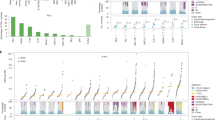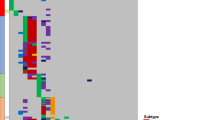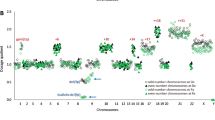Abstract
Gross cytogenetic anomalies are traditionally being used as diagnostic, prognostic and therapeutic markers in the clinical management of cancer, including childhood acute lymphoblastic leukemia (ALL). Recently, it has become increasingly clear that genetic lesions driving tumorigenesis frequently occur at the submicroscopic level and, consequently, escape standard cytogenetic observations. Therefore, we profiled the genomes of 40 childhood ALLs at high resolution. We detected multiple de novo genetic lesions, including gross aneuploidies and segmental gains and losses, some of which were subtle and affected single genes. Many of these lesions involved recurrent (partially) overlapping deletions and duplications, containing various established leukemia-associated genes, such as ETV6, RUNX1 and MLL. Importantly, the most frequently affected genes were those controlling G1/S cell cycle progression (e.g. CDKN2A, CDKN1B and RB1), followed by genes associated with B-cell development. The latter group includes microdeletions of the B-lineage transcription factors PAX5, EBF, E2-2 and IKZF1 (Ikaros), as well as genes with other established roles in B-cell development, that is RAG1 and RAG2, FYN, PBEF1 or CBP/PAG. The fact that we frequently encountered multiple lesions affecting genes involved in cell cycle regulation and B-cell differentiation strongly suggests that both these processes need to be targeted independently and simultaneously to trigger ALL development.
This is a preview of subscription content, access via your institution
Access options
Subscribe to this journal
Receive 12 print issues and online access
$259.00 per year
only $21.58 per issue
Buy this article
- Purchase on Springer Link
- Instant access to full article PDF
Prices may be subject to local taxes which are calculated during checkout



Similar content being viewed by others
Accession codes
References
Pui CH, Relling MV, Downing JR . Acute lymphoblastic leukemia. N Engl J Med 2004; 350: 1535–1548.
Chessels JM, Swansbury GJ, Reeves B, Bailey CC, Richards SM . Cytogenetics and prognosis in childhood lymphoblastic leukaemia: results of MRC UKALL X. Medical Research Council Working Party in childhood leukaemia. Br J Haematol 1997; 99: 93–100.
Heerema NA, Nachman JB, Sather HN, Sensel MG, Lee MK, Hutchinson R et al. Hypodiploidy with less than 45 chromosomes confers adverse risk in childhood acute lymphoblastic leukemia: a report from the children's cancer group. Blood 1999; 94: 4036–4045.
Mrozek K, Heerema NA, Bloomfield CD . Cytogenetics in acute leukemia. Blood Rev 2004; 18: 115–136.
Druker BJ, Sawyers CL, Kantarjian H, Resta DJ, Reese SF, Ford JM et al. Activity of a specific inhibitor of the BCR-ABL tyrosine kinase in the blast crisis of chronic myeloid leukemia and acute lymphoblastic leukemia with the Philadelphia chromosome. N Engl J Med 2001; 344: 1038–1042.
de Vries BB, Pfundt R, Leisink M, Koolen DA, Vissers LE, Janssen IM et al. Diagnostic genome profiling in mental retardation. Am J Hum Genet 2005; 77: 606–616.
Leung YF, Cavalieri D . Fundamentals of cDNA microarray data analysis. Trends Genet 2003; 19: 649–659.
Nannya Y, Sanada M, Nakazaki K, Hosoya N, Wang L, Hangaishi A et al. A robust algorithm for copy number detection using high-density oligonucleotide single nucleotide polymorphism genotyping arrays. Cancer Res 2005; 65: 6071–6079.
Redon R, Ishikawa S, Fitch KR, Feuk L, Perry GH, Andrews TD et al. Global variation in copy number in the human genome. Nature 2006; 444: 444–454.
Bernardin F, Yang Y, Cleaves R, Zahurak M, Cheng L, Civin CI et al. TEL-AML1, expressed from t(12;21) in human acute lymphocytic leukemia, induces acute leukemia in mice. Cancer Res 2002; 62: 3904–3908.
Strefford JC, van Delft FW, Robinson HM, Worley H, Yiannikouris O, Selzer R et al. Complex genomic alterations and gene expression in acute lymphoblastic leukemia with intrachromosomal amplification of chromosome 21. Proc Natl Acad Sci USA 2006; 103: 8167–8172.
Menasce LP, Orphanos V, Santibanez-Koref M, Boyle JM, Harrison CJ . Common region of deletion on the long arm of chromosome 6 in non-Hodgkin's lymphoma and acute lymphoblastic leukaemia. Genes Chromosomes Cancer 1994; 10: 286–288.
Jackson A, Carrara P, Duke V, Sinclair P, Papaioannou M, Harrison CJ et al. Deletion of 6q16–q21 in human lymphoid malignancies: a mapping and deletion analysis. Cancer Res 2000; 60: 2775–2779.
Cao L, Guo B, Kang R, Yang M, Zhang Z, Wu X . Identification of a 2-cM minimal deletion at 6q16.3–21 in childhood acute lymphoblastic leukemia in China. Pediatr Blood Cancer 2005; 45: 732–733.
Strefford JC, Worley H, Barber K, Wright S, Stewart AR, Robinson HM et al. Genome complexity in acute lymphoblastic leukemia is revealed by array-based comparative genomic hybridization. Oncogene 2007, January 22 [E-pub ahead of print].
van Zelm MC, van der BM, de RD, Barendregt BH, de Haas EF, Reinders MJ et al. Ig gene rearrangement steps are initiated in early human precursor B cell subsets and correlate with specific transcription factor expression. J Immunol 2005; 175: 5912–5922.
Bertrand P, Bastard C, Maingonnat C, Jardin F, Maisonneuve C, Courel MN et al. Mapping of MYC breakpoints in 8q24 rearrangements involving non-immunoglobulin partners in B-cell lymphomas. Leukemia 2007; 21: 515–523.
Robinson WP . Mechanisms leading to uniparental disomy and their clinical consequences. Bioessays 2000; 22: 452–459.
Raghavan M, Lillington DM, Skoulakis S, Debernardi S, Chaplin T, Foot NJ et al. Genome-wide single nucleotide polymorphism analysis reveals frequent partial uniparental disomy due to somatic recombination in acute myeloid leukemias. Cancer Res 2005; 65: 375–378.
Okuda T, Shurtleff SA, Valentine MB, Raimondi SC, Head DR, Behm F et al. Frequent deletion of p16INK4a/MTS1 and p15INK4b/MTS2 in pediatric acute lymphoblastic leukemia. Blood 1995; 85: 2321–2330.
Lukas J, Parry D, Aagaard L, Mann DJ, Bartkova J, Strauss M et al. Retinoblastoma-protein-dependent cell–cycle inhibition by the tumour suppressor p16. Nature 1995; 375: 503–506.
Sharpless NE . INK4a/ARF: a multifunctional tumor suppressor locus. Mutat Res 2005; 576: 22–38.
Hannon GJ, Beach D . p15INK4B is a potential effector of TGF-beta-induced cell cycle arrest. Nature 1994; 371: 257–261.
Chandramohan V, Jeay S, Pianetti S, Sonenshein GE . Reciprocal control of Forkhead box O 3a and c-Myc via the phosphatidylinositol 3-kinase pathway coordinately regulates p27Kip1 levels. J Immunol 2004; 172: 5522–5527.
Moberg KH, Bell DW, Wahrer DC, Haber DA, Hariharan IK . Archipelago regulates Cyclin E levels in Drosophila and is mutated in human cancer cell lines. Nature 2001; 413: 311–316.
Welcker M, Orian A, Grim JE, Eisenman RN, Clurman BE . A nucleolar isoform of the Fbw7 ubiquitin ligase regulates c-Myc and cell size. Curr Biol 2004; 14: 1852–1857.
Veal E, Eisenstein M, Tseng ZH, Gill G . A cellular repressor of E1A-stimulated genes that inhibits activation by E2F. Mol Cell Biol 1998; 18: 5032–5041.
Di Bacco A, Gill G . The secreted glycoprotein CREG inhibits cell growth dependent on the mannose-6-phosphate/insulin-like growth factor II receptor. Oncogene 2003; 22: 5436–5445.
Nutt SL, Heavey B, Rolink AG, Busslinger M . Commitment to the B-lymphoid lineage depends on the transcription factor Pax5. Nature 1999; 401: 556–562.
Busslinger M . Transcriptional control of early B cell development. Annu Rev Immunol 2004; 22: 55–79.
Aspland SE, Bendall HH, Murre C . The role of E2A-PBX1 in leukemogenesis. Oncogene 2001; 20: 5708–5717.
Bain G, Maandag EC, Izon DJ, Amsen D, Kruisbeek AM, Weintraub BC et al. E2A proteins are required for proper B cell development and initiation of immunoglobulin gene rearrangements. Cell 1994; 79: 885–892.
Lin H, Grosschedl R . Failure of B-cell differentiation in mice lacking the transcription factor EBF. Nature 1995; 376: 263–267.
Wikstrom I, Forssell J, Goncalves M, Colucci F, Holmberg D . E2-2 regulates the expansion of pro-B cells and follicular versus marginal zone decisions. J Immunol 2006; 177: 6723–6729.
Georgopoulos K . Haematopoietic cell-fate decisions, chromatin regulation and ikaros. Nat Rev Immunol 2002; 2: 162–174.
Bassing CH, Swat W, Alt FW . The mechanism and regulation of chromosomal V(D)J recombination. Cell 2002; 109 (Suppl): S45–S55.
Saijo K, Schmedt C, Su IH, Karasuyama H, Lowell CA, Reth M et al. Essential role of Src-family protein tyrosine kinases in NF-kappa B activation during B cell development. Nat Immunol 2003; 4: 274–279.
Dobenecker MW, Schmedt C, Okada M, Tarakhovsky A . The ubiquitously expressed Csk adaptor protein Cbp is dispensable for embryogenesis and T-cell development and function. Mol Cell Biol 2005; 25: 10533–10542.
Brunner C, Laumen H, Nielsen PJ, Kraut N, Wirth T . Expression of the aldehyde dehydrogenase 2-like gene is controlled by BOB.1/OBF.1 in B lymphocytes. J Biol Chem 2003; 278: 45231–45239.
Samal B, Sun Y, Stearns G, Xie C, Suggs S, McNiece I . Cloning and characterization of the cDNA encoding a novel human pre-B-cell colony-enhancing factor. Mol Cell Biol 1994; 14: 1431–1437.
Fukuhara A, Matsuda M, Nishizawa M, Segawa K, Tanaka M, Kishimoto K et al. Visfatin: a protein secreted by visceral fat that mimics the effects of insulin. Science 2005; 307: 426–430.
Hug C, Lodish HF . Visfatin: a new adipokine. Science 2005; 307: 366–367.
Tsuzuki S, Seto M, Greaves M, Enver T . Modeling first-hit functions of the t(12;21) TEL-AML1 translocation in mice. Proc Natl Acad Sci USA 2004; 101: 8443–8448.
Downing JR, Mullighan CG . Tumor-specific genetic lesions and their influence on therapy in pediatric acute lymphoblastic leukemia. Hematol Am Soc Hematol Educ Program 2006, 118–122.
Medina KL, Singh H . Genetic networks that regulate B lymphopoiesis. Curr Opin Hematol 2005; 12: 203–209.
Hagman J, Lukin K . Transcription factors drive B cell development. Curr Opin Immunol 2006; 18: 127–134.
Acknowledgements
We thank E-J Kamsteeg, G Merkx and I Janssen for their valuable contributions, and Drs A Simons and M Stevens-Kroef for critically reading the article. We are grateful to Dr ER van Wering from the Dutch Childhood Oncology Group and the Dutch Workgroup Cancer Genetics and Cytogenetics (NWKGC) for material and scientific interactions. This work was supported by the Dutch Cancer Foundation and KiKa.
Author information
Authors and Affiliations
Corresponding author
Additional information
Supplementary Information accompanies the paper on the Leukemia website (http://www.nature.com/leu)
Supplementary information
Rights and permissions
About this article
Cite this article
Kuiper, R., Schoenmakers, E., van Reijmersdal, S. et al. High-resolution genomic profiling of childhood ALL reveals novel recurrent genetic lesions affecting pathways involved in lymphocyte differentiation and cell cycle progression. Leukemia 21, 1258–1266 (2007). https://doi.org/10.1038/sj.leu.2404691
Received:
Accepted:
Published:
Issue Date:
DOI: https://doi.org/10.1038/sj.leu.2404691
Keywords
This article is cited by
-
Prevalence and prognostic significance of IKZF1 deletion in paediatric acute lymphoblastic leukemia: A systematic review and meta-analysis
Annals of Hematology (2023)
-
HDAC7 is a major contributor in the pathogenesis of infant t(4;11) proB acute lymphoblastic leukemia
Leukemia (2021)
-
Advances in germline predisposition to acute leukaemias and myeloid neoplasms
Nature Reviews Cancer (2021)
-
Src Family Protein Kinase Controls the Fate of B Cells in Autoimmune Diseases
Inflammation (2021)
-
Allogeneic HCT for adults with B-cell precursor acute lymphoblastic leukemia harboring IKZF1 gene mutations. A study by the Acute Leukemia Working Party of the EBMT
Bone Marrow Transplantation (2021)



